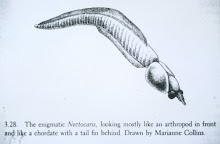Metonymic Orbs. We've often seen drawings of eyes affixed with limbs and slotted mouths. Eyes, in short, substituted for creatures' heads and bodies.(1) This form of metonymy is as common for animals as humans. Equally so, substitutions of heads for eyes.
Less often, the eye replaces the head of a quadruped. Equally atypical, eyes in place of fur. Likelier, to find the bather's averted glance awaiting the voyeur through the torso's white-misted nipples: inward-turned but certainly not unwatched.
Full substitutions of eyes with veinage are slightly less abundant. One thinks of drawings in which orbs with elongated stems slither along the ground, signifying alarmed worms, asps of the imagination. Sighted flowers and plants: less common still, but equally obvious. Inarguably, examples must exist of an ocular sun gazing down at a field of sunflower eyes -- blind ovals straining their tangles of scarlet stems.
No reason, then, to disinclude other metonymic forms: Eyes with artfully knotted stems for formally attired human limbs. Carved birds on plates with eyes in place of organs. Half-hidden eyes in the slots of cutaway creatures (animals that resemble cross-section illustrations in anatomy charts, and camouflage themselves as diagrams in doctors' offices). Eyes floating, matriced within transparent cave crustaceans. Eyes for cryptic parts embedded in the sides of Precambrian crawlers.
The Repetition of Eyes: Orb armies, eye-swarms, eye-pores; patterns of perforations and blemishes flowering into eyes; staring cheese-holes and haunted holes in fabric; floating masses of wincing orbs in place of bubbles; cells, hives, infestations of eyes like liquescent eggs.
Single-object substitutions: Lips, nostrils, wounds and ear apertures as eyes. Lone swordfish with staring gills. One tarot card symbolizing Dennis Oppenheimer's displacement: a single dilated pupil sprouting thorns at the center of the desert floor.
Cosmology: Perhaps what we glimpse above us is "The Father," as so many hope. But perhaps it is only a crowd of strangers' sightless spheres. Glowing sclera-globes revolve in place of stars. The night sky itself: an all-engulfing pupil.
Culinary substitutions: A silent filmstar's fear materializes in a pan, eggs' flickering yolks enclosed in shriveling lashes. Breakfast is served to the frail, sick and sleepless. Later, round puddings and viscous white sweets will be distributed to rested diners; to those in between, gazing caviar.
Precious Gems and Metals: Baubles like pupils with chromatic irises; ring-mounted jewels, the names of which often indicate their resemblance to animals' eyes, displaced by the literal object:-- colored exactly the same way, pupils moving when the wearer isn't looking. The inverse: A living tiger with jewel stones for eyes. He can see through shale, metal and wood to the ready meat beneath.
Behind us, a conspiracy of patterns in ornate wallpaper and furniture: pupiled crescents appear when detailed surfaces converge.
Put away your book, Reader, lest the blurred print gaze back dully. Fall asleep, and follow the small letters darting together. Orbs rise through the armrests of your chair; the dream-world watches you intensely. Staring doorbells ring for you as long as you don't touch them. Neighbors swivel in your direction, neck-stems straining as you sink out of range.
Lower Sleep's hood, sleeper. Picture yourself as squiggles on its chrome. Walk-about, lyre. Blind man, draw the blind.
=================================
(1) One could assert that, technically, an eye in place of the head alone is an instance of synecdoche, not metonymy, but head-reduction and body-substitution are so similar that affording separate classifications to each would be misleading, which could cause the Platonic Universe to glitch until a perfect repairgod appeared.
Subscribe to:
Post Comments (Atom)


No comments:
Post a Comment